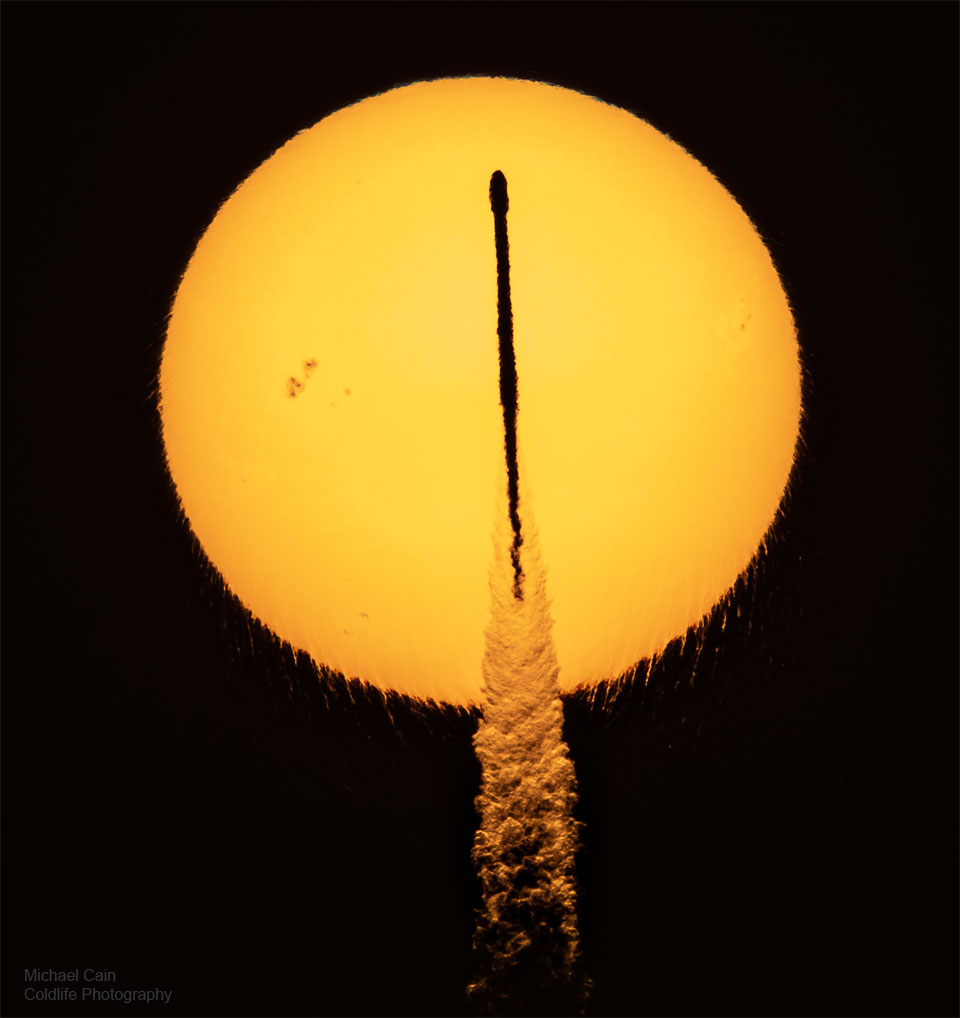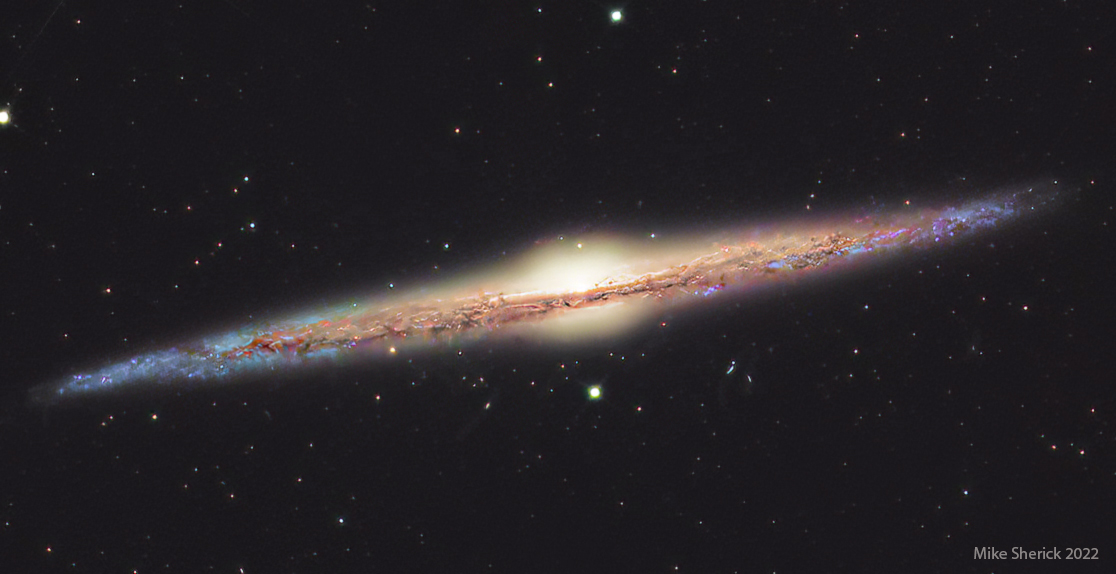Nombre total de pages vues
01/06/2022
ASTROPHOTOGRAPHIE - Voie lactée dans un ciel limpide
ASTRONOMY - Tau Herculids Meteors over Kitt Peak Telescopes
2022 June 1
Image Credit & Copyright: Jianwei Lyu (Steward Obs., U. Arizona)
Explanation: It wasn't the storm of the century -- but it was a night to remember. Last night was the peak of the Tau Herculids meteor shower, a usually modest dribble of occasional meteors originating from the disintegrating Comet 73P/Schwassmann-Wachmann 3. This year, calculations showed that the Earth might be passing through a particularly dense stream of comet debris -- at best creating a storm of bright meteors streaking out from the constellation of Hercules. What actually happened fell short of a meteor storm, but could be called a decent meteor shower. Featured here is a composite image taken at Kitt Peak National Observatory in Arizona, USA accumulated over 2.5 hours very late on May 30. Over that time, 19 Tau Herculids meteors were captured, along with 4 unrelated meteors. (Can you find them?) In the near foreground is the Bok 2.3-meter Telescope with the 4.0-meter Mayall Telescope just behind it. Next year, the annual Tau Herculids are expected to return to its normal low rate, with the next active night forecast for 2049.
31/05/2022
ASTRONOMY - Rocket Transits Rippling Sun
2022 May 31
Image Credit & Copyright: Michael Cain
Explanation: The launch of a rocket at sunrise can result in unusual but intriguing images that feature both the rocket and the Sun. Such was the case last month when a SpaceX Falcon 9 rocket blasted off from NASA's Kennedy Space Center carrying 53 more Starlink satellites into low Earth orbit. In the featured launch picture, the rocket's exhaust plume glows beyond its projection onto the distant Sun, the rocket itself appears oddly jagged, and the Sun's lower edge shows peculiar drip-like ripples. The physical cause of all of these effects is pockets of relatively hot or rarefied air deflecting sunlight less strongly than pockets relatively cool or compressed air: refraction. Unaware of the Earthly show, active sunspot region 3014 -- on the upper left -- slowly crosses the Sun.
30/05/2022
ASTRONOMY - Red Crepuscular Rays from an Eclipse
2022 May 30
Image Credit & Copyright: Fefo Bouvier
Explanation: What's happening behind that island? Things both expected and unexpected. Expected, perhaps, the pictured rays of light -- called crepuscular rays -- originate from the Sun. Unexpected, though, the Sun was being partially eclipsed by the Moon at the time -- late last month. Expected, perhaps, the Sun's rays are quite bright as they shine through gaps in below-horizon clouds. Unexpected, though, the crepuscular rays are quite red, likely the result an abundance of aerosols in Earth's atmosphere scattering away much of the blue light. Expected, with hope, a memorable scene featuring both the Moon and the Sun, superposed. Unfortunately, from this location -- in Uruguay looking toward Argentina -- clouds obscured the eclipse -- which wasn't completely unexpected. However, after packing up to go home, the beauty of bright red crepuscular rays emerged -- quite unexpectedly. Oh -- and that island on the horizon -- it's really two islands.
29/05/2022
MERVEILLEUX MONDE SOUS-MARIN - L'atoll de Fakarava, dans l'archipel des Tuamotu
© Photographe Alexis Rosenfeld
SCIENCE INSOLITE - On en pince pour la Nature
© Mehmet Ali Uysal-sculpteur turc
ASTRONOMY - Simulation TNG50: A Galaxy Cluster Forms
2022 May 29
Video Credit: IllustrisTNG Project; Visualization: Dylan Nelson (Max Planck Institute for Astrophysics) et al.
Music: Symphony No. 5 (Ludwig van Beethoven), via YouTube Audio Library
Explanation: How do clusters of galaxies form? Since our universe moves too slowly to watch, faster-moving computer simulations are created to help find out. A recent effort is TNG50 from IllustrisTNG, an upgrade of the famous Illustris Simulation. The first part of the featured video tracks cosmic gas (mostly hydrogen) as it evolves into galaxies and galaxy clusters from the early universe to today, with brighter colors marking faster moving gas. As the universe matures, gas falls into gravitational wells, galaxies forms, galaxies spin, galaxies collide and merge, all while black holes form in galaxy centers and expel surrounding gas at high speeds. The second half of the video switches to tracking stars, showing a galaxy cluster coming together complete with tidal tails and stellar streams. The outflow from black holes in TNG50 is surprisingly complex and details are being compared with our real universe. Studying how gas coalesced in the early universe helps humanity better understand how our Earth, Sun, and Solar System originally formed.
28/05/2022
26/05/2022
ASTRONOMY - NGC 4565: Galaxy on Edge
2022 May 26
Image Credit & Copyright: Michael Sherick
Explanation: Magnificent spiral galaxy NGC 4565 is viewed edge-on from planet Earth. Also known as the Needle Galaxy for its narrow profile, bright NGC 4565 is a stop on many telescopic tours of the northern sky, in the faint but well-groomed constellation Coma Berenices. This sharp, colorful image reveals the galaxy's boxy, bulging central core cut by obscuring dust lanes that lace NGC 4565's thin galactic plane. NGC 4565 itself lies about 40 million light-years distant and spans some 100,000 light-years. Easily spotted with small telescopes, sky enthusiasts consider NGC 4565 to be a prominent celestial masterpiece Messier missed.
25/05/2022
ASTRONOMIE - Spectacle grandiose
Les aurores boréales illuminent le ciel au-dessus du phare St Marys à Whitley Bay, au Royaume-Uni. Le phénomène a atteint le niveau G4 de te...

-
2022 September 26 All the Water on Planet Earth Illustration Credit: Jack Cook, Adam Nieman, Woods Hole Oceanographic Institution ; Data ...
-
2025 May 11 The Surface of Venus from Venera 14 Image Credit: Soviet Planetary Exploration Program , Venera 14 ; Processing & Copyri...







